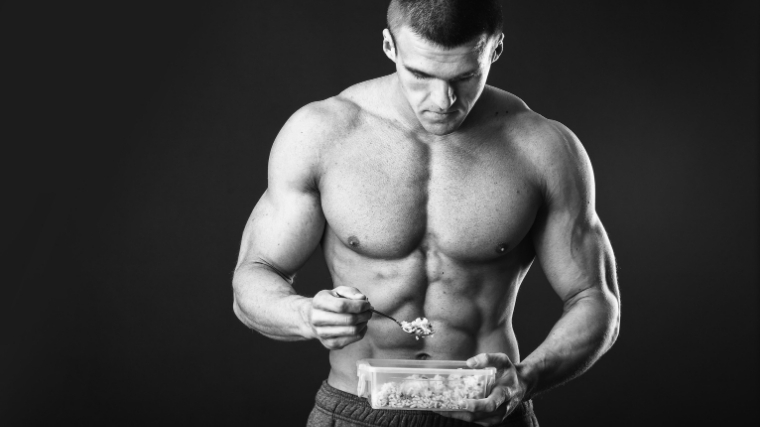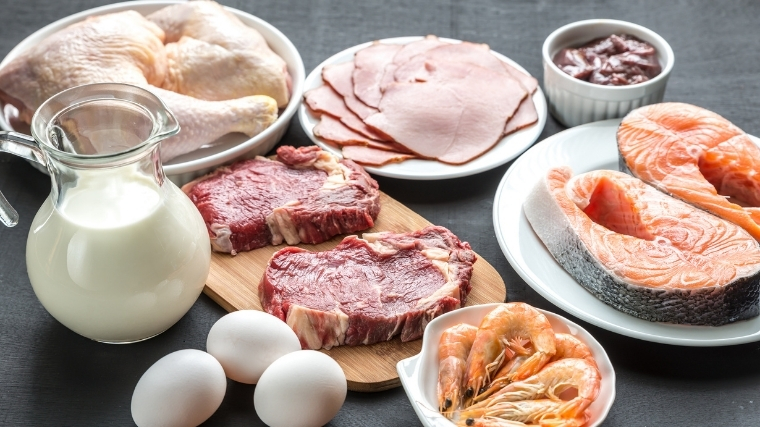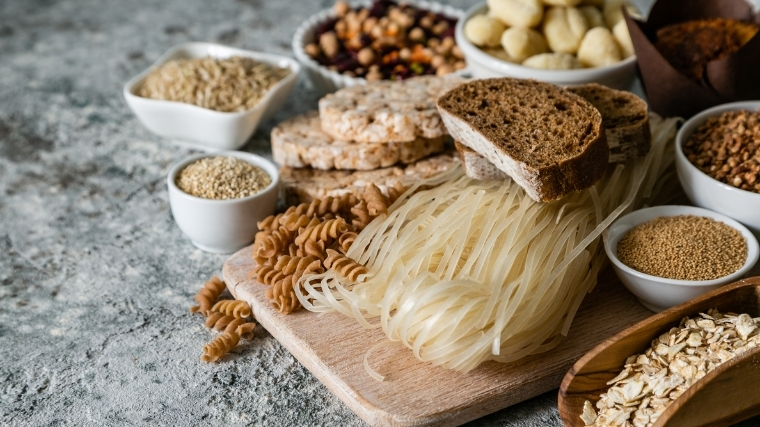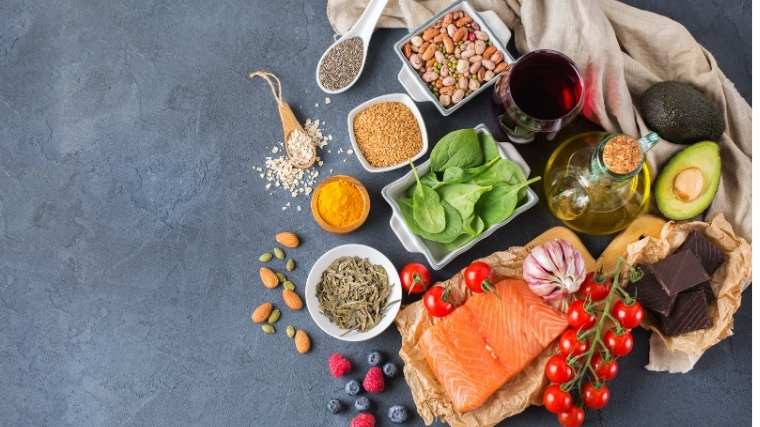There are tons of diet and nutrition clichés we can throw at you: “Muscles are made in the kitchen, not the gym,” “you can’t out-exercise a bad diet,” and the age-old classic “you are what you eat.” Here’s the thing, though — they’re all true. Lifting weights for one hour (for a 185-pound man) burns 266 calories. To put that into perspective, that’s the same amount as one pack of Skittles. So, yeah, you can easily out-eat your training program. And don’t think that more is better when your goal is to gain muscle. On average, you want to be eating just 200 calories (so, less than a pack of skittles) above your total daily energy expenditure (how many calories you burn in a day).
When it comes to gaining muscle (or losing fat), your diet should be treated like a high-wire balancing act. Eat too little, and you’ll burn up your hard-earned muscle. Eat too much, and by the time you’re fully bulked, your new muscle will be hiding under a fat sweater. Use this guide to nail down your diet and ensure your endless hours in the gym are not wasted.
How to Gain Muscle
- Calculate Your Calories
- Track Your Macros
- Get the Right Calorie-Counting Tools
- Dial-in Your Protein Intake
- Master the Anabolic Window
- Eat the Right Amount of Carbs
- Eat the Right Amount of Fat
- Outline a Plan
Editor’s note: The content on BarBend is meant to be informative in nature, but it should not be taken as medical advice. The opinions and articles on this site are not intended for use as diagnosis, prevention, and/or treatment of health problems. It’s always a good idea to talk to your doctor before beginning a new fitness, nutritional, and/or supplement routine. None of these supplements are meant to treat or cure any disease. If you feel you may be deficient in a particular nutrient or nutrients, please seek out a medical professional.
How to Gain Muscle Video Guide
Here’s our video on how to specifically dial in your macros to gain muscle in the kitchen.
Calculate Your Calories
In your muscle-building journey, you can’t guess how many calories you’re consuming or burning throughout the day — you need to be meticulous about it. If you eat too little, you won’t gain any muscle at all, and if you eat too much, you’ll get fat.
That being said, you’ll need to eat an excess amount of calories to get muscular. After all, you’re in this to get bigger and stronger, right? So how do you walk the line between eating for muscle growth and avoiding eating too much?
First, you have to figure out how many calories you need to maintain your weight. To that number, you’d add 100-300 extra calories every day — eating any more might lead to the fat gain you are trying to avoid. If you’re still having trouble gaining muscle — and your workout routine and sleep are on point — try adding 100 calories and see if that works. Be sure to weigh yourself weekly. You can even weigh yourself three times per week or daily. This may sound excessive, but monitoring the scale will A) help keep you accountable and B) allow you to monitor shifts in weight. If you’re not seeing any movement in the first two weeks, then up your calories.
The best ways to consume surplus calories are by increasing your portion sizes or eating additional meals and snacks. While the gym bro advice of eating smaller, more frequent meals isn’t essential, it may be easier for you to hit your caloric goal that way. But if you can fit that number into three-squared meals, then go for it.
[Read More: Best Fat Burners, With Expert Advice from an RD]
Track Your Macros
When it comes to weight, it’s a matter of calories in vs. calories out. But if you’re looking to accomplish a specific goal — such as gaining muscle — you need to make sure your calories come from appropriate sources, which means tracking your macronutrients (protein, carbohydrates, and fats).

Your body reacts differently to calories from protein than calories from fat or carbs — and each macronutrient has an important role. We’ll go a little more in-depth below, but for now, all you need to know is that protein is the building block of muscles, carbohydrates provide energy for workouts, and fats help hormonal function such as testosterone (which will help you in rooms other than the gym).
Each macronutrient also makes up the total number of calories in food. Protein and carbohydrates have four calories per gram, and fats have nine calories per gram.
How you distribute these macros is up to you and your personal trainer/nutritionist and your specific muscle-building goal. For example, someone looking to drop body fat but hold onto lean muscle will have a different macro split than someone who’s starting skinny and wants to put on size. One study in the journal Sports Med recommends 55 percent carbs, 30 percent protein, and 15 percent fats for a typical bodybuilding diet, but again, find what works best for you. (1)
You can also refer to BarBend’s macronutrient calculator to find your starting macros. Remember to be honest about your activity level.
Macronutrient Calculator
Calorie-counting tools
Calorie and macro counting can be a full-time job, and to do it correctly, you’ll need the proper tools.
First, you’ll want to find a way to log your calorie and macro intake, such as a calorie-tracking app. MyFitnessPal is one of the most popular choices. It offers a large food database, is equipped with a barcode scanner for packaged foods, and can pair up with many fitness trackers and bodyweight scales. Another lesser-known option is Chronometer, which some believe offers more accurate food entries.
You’ll also want a food scale to measure everything you’re eating. As we said, it’s not enough to guess how much you’re putting in your body — you need to be exact, and only a food scale will accomplish that. Think that sounds a little high strung? Take any food out of your cabinet and look at the serving size — we’ll use peanut butter for this example — and eyeball one two-tablespoon (32-gram) serving into one bowl. Then, weigh out 32 grams of it onto your scale. See a difference? The unweighed serving is probably bigger and therefore packed with more calories and fats than you need.
It was alluded to above, but you’ll also want to buy a body weight scale. Whether you want to gain fat or lose muscle, you need to know which way your weight is trending. (You can also take full-body pictures and measure your waist and muscles as another way to track progress. Which way your weight is trending — and how quickly — will help you decide how many calories to either add or subtract weekly.
Additionally, you’ll want to keep track of how many calories you burn during the day, especially if you do something like hike a 3,000-foot mountain. That kind of strenuous activity is going to require a lot of calories you’ll have to replace. If you’re serious about tracking your caloric burn, it might be worth it to invest in something like a FitBit, though it should be noted there are questions on how accurate those are in tracking calories. (2)
[Read More: The Best Supplements for Weight Loss]
Meet the Macros
There are three macronutrients — proteins, carbs, and fats. Each one plays an important role in your muscle-building quest. Here’s a breakdown of each of the three macronutrients.
Protein
Protein is, without a doubt, the most important macronutrient for those looking to build muscle — and even for those looking to lose weight. As we stated previously, protein is the building block of muscle. Another benefit: protein speeds up the thermic effect of feeding, or the number of calories burnt through digestion. In other words, you’ll burn more calories — thereby keeping body fat down — just by eating protein (to an extent).

So that means you should go to the store and pick up everything that says “20 grams of protein” on it, right? Wrong.
First of all, it should be noted that not all proteins are created equally. Protein molecules are formed by amino acids, some of which are created in the body and some that need to be obtained through diet. The latter group is called essential amino acids (or EAAs), and there are nine of them, and each plays a vital role in your health and building muscle.
If you eat a typical Western diet, odds are you don’t have to worry about obtaining all your essential aminos. However, vegetarians and vegans should be a little more conscious. That’s because vegetable-based proteins, whether that be lentils or a Beyond Burger, lack all nine EAAs (the only exception to this are soybeans, which contain all nine).
To counter this, eat complementary amino acids. Beans, a good source of protein, lack the EAA methionine, which is present in rice and other grains. You can also supplement with BCAAs, or branched-chain amino acids, though you don’t want to rely on these supplements to get your full EAA allotment.
The Anabolic Window and Protein Timing
You’ve probably heard of the “anabolic window,” or the theory that there’s a limited amount of time where muscles can rapidly absorb protein and carbs following an intense workout, and thereby improve muscle growth. This is a popular urban legend among gym bros, but there’s limited proof that it’s real.
New studies have shown that the so-called “anabolic window” is only effective for dedicated bodybuilding athletes, so unless you’re dedicating your life to the sport, you don’t need to rush to down a protein shake after your workout. (3)
Instead, pay attention to evenly distributing your protein intake throughout the day. Studies have shown this strategy has led to increased protein synthesis and improved body composition. (4)
Best Protein Sources
Here are some protein sources recommended by the Cleveland Clinic:
- Edamame
- Lentils
- Split Peas
- Low-fat Meats (such as boneless, skinless chicken breast)
- Greek Yogurt
- Low-fat cottage cheese
- Canned Tuna
- Egg Whites
Carbohydrates
Carbs often get a bad rap, and there are many types of diets dedicated to helping you avoid them (ketogenic, carnivore, and Atkins, to name a few). When it comes to muscle-building, though, they’re an important part of your nutrition plan. Your body takes carbs and converts them to glucose, which is the body’s preferred energy source. Furthermore, your brain relies on glucose to carry out its daily functions — so it’s good for your mental and physical health.

Carbs also replenish glycogen, which provides energy to our muscles. Without glycogen, your biceps wouldn’t be able to hold up to repeated curls in the gym.
One of the reasons carbs have a bad reputation is that people don’t eat the right kind of carbs in most Western countries. Way too many Americans eat refined starches (potato chips, pastries, etc.) instead of whole grains (oatmeal and whole-wheat pasta and bread).
Studies have shown the quality of a macronutrient is vastly superior to how much of it you eat. This is easy to see when you consider white vs. whole-wheat bread — the former lacks the nutrient-dense germ of the grain. (5)
Your carbohydrate sources should also contain plenty of fiber. According to the U.S. Department of Agriculture, the average American is only eating 10-15 grams of fiber per day when the recommended intake is 25 grams for women and 38 grams for men. Fiber can help you stay full throughout the day, so you’re less likely to succumb to unwanted cravings. To make sure you’re getting enough, aim to consume at least one gram of fiber for every five to 10 grams of carbs you consume.
Best Carb Sources
Here are some of the best sources of carbohydrates, as suggested by the Mayo Clinic:
- Barley
- Brown rice
- Buckwheat
- Bulgur (cracked wheat)
- Millet
- Oatmeal
- Popcorn
- Whole-wheat bread, pasta, or crackers
Fats
Fats are no stranger to controversy — the media and researchers change their minds on whether it’s bad or good every other year. “Egg yolks are good,” we’re told one day, and the next, we’re warned to stay away from them because of their fat content.

So why are fats necessary? As we stated before, they assist in hormonal functions. One study in The Journal of Urology linked low-fat diets to low testosterone counts in men. Testosterone is a necessary hormone for muscle growth. (6)
You’ve probably heard some talk about “good fats” and “bad fats.” It can be a confusing topic, but here’s what you need to know: Limit your consumption of saturated and trans fats as these have been shown to increase your risk of heart disease and type 2 diabetes. Stick with monounsaturated and polyunsaturated fats, aka the kind of that have been shown to improve your overall health and provide nutrients essential for cellular function.
Best Fats Sources
Here are some examples of good fats, provided by the American Heart Association:
- Avocado
- Canola Oil
- Sesame Oil
- Sunflower Oil
- Albacore tuna
- Herring
- Lake trout
- Mackerel
- Sardines
- Salmon
- Almonds
- Hazelnuts
- Peanuts
- Pistachios
- Pumpkin seeds
- Sunflower seeds
- Walnuts
Vitamins and Minerals
There are too many vitamins and minerals that play a key role in your body for us to go over here, but it’s vital that you’re getting a good amount of vitamins and nutrients through your diet. Consult a nutritionist to ensure there are no deficiencies that could lead to injury, illness, or impaired recovery.
How to Proceed
To recap, your nutrition is a key part of your muscle-building journey. Here are some key points to take away from this piece.
- Figure out your required caloric intake and macro split.
- Get the right tools for the job.
- Eat high-quality sources of protein, carbs, and fats.
- Ensure you’re not deficient in any vitamin or mineral.
- You’ll also want to read about how to build muscle, as training is another piece to the gains puzzle.
More Muscle Gain Nutrition Tips
Find out more about how you should be fueling your body for ultimate muscle gains. Check out these articles below.
- Nutrition Tips for Bulking: 10 Tips for Intelligent Muscle Gain
- Intermittent Fasting 101: A Guide to Benefits, Muscle Gain, and More
- Fat Loss Vs. Muscle Gain: The Right Macros for Your Goals
References
- Lambert CP, Frank LL, Evans WJ. Macronutrient considerations for the sport of bodybuilding. Sports Med. 2004;34(5):317-27. doi: 10.2165/00007256-200434050-00004. PMID: 15107010.
- Feehan LM, Geldman J, Sayre EC, et al. Accuracy of Fitbit Devices: Systematic Review and Narrative Syntheses of Quantitative Data. JMIR Mhealth Uhealth. 2018;6(8):e10527. Published 2018 Aug 9. doi:10.2196/10527
- Mori H. Effect of timing of protein and carbohydrate intake after resistance exercise on nitrogen balance in trained and untrained young men. J Physiol Anthropol. 2014;33(1):24. Published 2014 Aug 6. doi:10.1186/1880-6805-33-24
- Mamerow MM, Mettler JA, English KL, Casperson SL, Arentson-Lantz E, Sheffield-Moore M, Layman DK, Paddon-Jones D. Dietary protein distribution positively influences 24-h muscle protein synthesis in healthy adults. J Nutr. 2014 Jun;144(6):876-80. doi: 10.3945/jn.113.185280. Epub 2014 Jan 29. PMID: 24477298; PMCID: PMC4018950.
- Shan Z, Guo Y, Hu FB, Liu L, Qi Q. Association of Low-Carbohydrate and Low-Fat Diets With Mortality Among US Adults. JAMA Intern Med. 2020;180(4):513–523. doi:10.1001/jamainternmed.2019.6980
- Fantus, R. J., Halpern, J. A., Chang, C., Keeter, M. K., Bennett, N. E., Helfand, B., & Brannigan, R. E. (2020). The Association between Popular Diets and Serum Testosterone among Men in the United States. Journal of Urology, 203(2), 398–404. https://doi.org/10.1097/ju.0000000000000482
Featured image: Alexander Lukatskly / Shutterstock